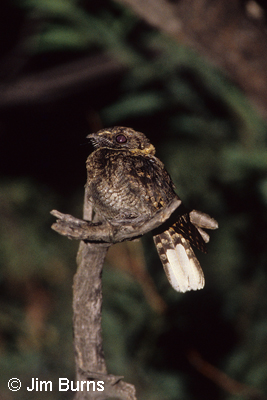
But wait, there's more. The common English names for the two North American branches of the family are nighthawk and nightjar. These are ten inch, cryptically colored, brown birds, active mostly after dark when they "hawk" flying insects and "jar" the night with their loud, distinctive calls
Because of their nocturnal habits and intricate camouflage, the Caprimulgids are listed taxonomically after the owls. Like the owls, they have huge eyes for nighttime light gathering, but there are many dissimilarities. They have weak feet and short legs suitable only for perching, not capturing prey. Their bills are relatively small but are surrounded by long rictal bristles which help funnel flying insects into the oversized mouth gape.
Our two nighthawks, common and lesser, are more frequently seen than the nightjars, typically snatching insects attracted to the bright lights of sports fields, billboards, and freeway ramps. Their calls are buzzy trills, less distinct and less often heard than those of the nightjars. They have long tails and long, pointed wings facilitating prolonged and maneuverable aerial feeding. Flight is typically erratic and bat-like. Like other insectivores these birds are migratory, returning to our temperate climate to breed in the spring when insects become plentiful.
The nightjar branch of the family is much more likely to be heard than seen, and their vocalizations are the key to identifying them to species. The fun part is that the species names for the two most common Arizona nightjars reflect their "songs." The whip-poor-will has an explosive, three syllable whistle which sounds like its name, and the common poorwill has a soft two syllable call which aurally resembles "poor will." Whips inhabit higher elevations in our state, but poorwills can be found in the desert, most often seen as they sit horizontally in the middle of the road after dark, their huge eyes reflecting red in the headlights as they watch for bugs attracted to the heat of the pavement. Try McDowell Mountain Park or the dirt roads on the Tonto National Forest.
Finding a nighthawk in daylight is one of the biggest thrills for serious Arizona birders. Late last summer several lesser nighthawks were discovered on day roosts at the Desert Botanical Garden. Looking for the buff-collared nightjar, a Mexican goatsucker known to breed north of the border in only one isolated canyon west of Nogales, replicates for birders the search for the Holy Grail.
As you sit around your campfire in the desert this spring, listen for the distinctive, mournful call of the poorwill. It's not out looking for goats, but it might be interested in the insects attracted to your camp lantern. The "song" is easily mimicked by even the youngest campers, and you can explain the goatsucker legend and blame the funny name on Aristotle.